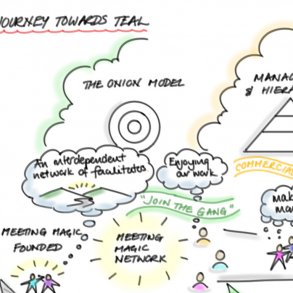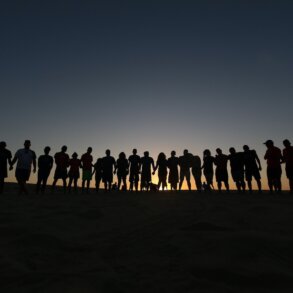Snippets from a conversation in the EE Community on Facebook
Last night I had a vivid dream that has stayed with me. In it, I was having coffee at a local hangout with some business people and educators. (That might have been part of my life some 30 years ago but it isn’t now.) While we were having coffee and chatting, I could feel the RO movement on the cusp of going mainstream, and that it just needed a little nudge. I sensed that business schools were ripe for creating an RO stream or track in their degree programs. As we talked, I saw the lights go on in the minds of some of the educators. The dream then switched, as dreams tend to do, and became less academic, shall we say. I could see and hear these words: If RO or Teal is the answer, what is the underlying question? And how far down does it go?
Then it became more finely grained, focusing on the 3 Teal breakthroughs. For example, if self-management is the answer, what is the deepest need or desire underneath it? In the dream, I played around with the two breakthroughs in this manner and was just at evolutionary purpose when I woke up. After, it struck me that tapping into the deepest underlying needs and desires of an individual, an organization, and even humanity, (in a bottom up way) is key. Of course I know this from my marketing and communications days, but it’s easy to forget in my excitement and desire to share the next best thing.
Edith I am with you every step of your dream. TEAL taps right into all this unexpressed potential within people and organisations and its time has come now – finally. No top down management can enable the emergence or nurture and sustain what is ready to be unleashed and freed. It helps us to become more deeply human with each other. thank you for reminding us.
Great dream! It seems to me that once basic safety and survival needs are taken care of, everyone wants to love and be loved, to belong and to give whatever it is within them to give, and be received by the world as they do so. I would see that as the route to wholeness. Self-management allows people to make their own choices of how to actualise that in their working lives. Evolutionary Purpose is an opportunity to align all of that with something that they are moved to see come about in the world.
Self-organisation in the workplace potentially creates a space where all of these things can come about, to the shared benefit of people and organization
Dear Edith, thank you for sharing this dream and vision. I’ve been teaching Integral Entrepreneurship and Integral Innovation at several business schools (e.g. Cass, ESCP) for some years now. When we started out it certainly felt like we were on the fringes … but that’s changed considerably over these past years :). It’s certainly not widespread yet, but the early signals for a wider adoption are all there.
I taught an MBA workshop on Teal Organizing at the Management Centre Innsbruck, and am opening my workshop material to any business school interested to further develop it for open source syndication..
Two things, I think, are key. The story and the human face. At least, this is what I discovered way back in the late 80’s when I was marketing director for a professional accounting association and accountable for recruiting business students to our after-degree professional program. I had a big budget and lots of media tools at my disposal, and the one that worked the best in this orange world (and I believe still does in any world) was the story and the human face. In that context it meant finding young (30ish), attractive, authentic people with that particular accounting designation in senior positions (vice presidents etc) to tell their stories and serve as “product champions” (much the same way that Laloux’s Teal organizations do in RO).
I took these “product champions” (forgive the Orange language) to various university and college events and had them tell their stories to students who longed for early career success. It was hugely successful all around. This was waaaay before social media, but I think the same principles still hold, maybe even more so. In this Teal or RO movement, we have a compelled WHY and WHAT (we all feel it in our bones), and I think we need to focus on the HOW if we want to create momentum and mainstream things. I’m curious about what has worked for you, when it comes to this sort of thing.
I love your dream, Edith, and want to answer in two ways, going deeper than practical answers, but similar to Jon Freeman‘s answer:
If Teal consciousness is the answer, the only questions/life conditions can come from Green Consciousness. That is the only stage READY and facing questions/limitations which would prompt maturation into Teal consciousness.
Orange consciousness has questions which ONLY Green can answer. Teal is quite irrelevant. That’s true overall; there might be momentary or minor flickers of interest, but they can’t stick. Nine-year-olds can explore wearing lipstick, but that doesn’t make them really ready to be sixteen. And sixteen is not the answer to their questions. TEN is. And life will take them there; it’s maturation. Stages are a bit more choiceful, but still maturational, not just a choice anyone can make. This error in understanding is rampant among those enthused about Teal.
From another perspective, though, there are some universal human needs, basic ones like Jon mentioned, and there are what Stephen Martineau called “elevator values” which are possible characteristics of a person at any stage. They include kindness and curiosity and I forget the third.
But even there, curiosity if present only is ready to look at and explore, whatever the person is ready for. If they are early in a stage, they are curious about what would help them mature into that stage.
If they are experiencing the natural LIMITS of the stage (not the shadow, which is entirely different) then they are ready to be curious about what’s a new worldview that would satisfy their new needs.
A partial agreement from me to Om-Alia Bastet above. I would add that life is asking the questions anyway. The VUCA conditions, the sustainability issues and the high-stress state of corporate existence are all indications that fresh responses are required that have not been delivered by previous stages. The fact that many of the people and organisations are not yet ready to recognise the nature of the questions being asked, and that individuals don’t have the perceptual frame to recognise what lies beneath much of what we are collectively experiencing, does not take away the need.
What we are conscious of at any time does tend to be less than what is actually happening. And even those whose perceptual systems are in Amber or Orange have as much need of the new ways as those who operate from later frames. That means that the task of those who can see the bigger picture is to support the whole by helping to develop systems / cultures / organisations which are constructed from Teal thinking and above, and which create functional places for those in earlier stages to inhabit with ease.
Thanks Jon for this: “That means that the task of those who can see the bigger picture is to support the whole by helping to develop systems / cultures / organisations which are constructed from Teal thinking and above, and which create functional places for those in earlier stages to inhabit with ease”
Jon, I highly value your precise and elegant articulation of that task. Could you elaborate on the FUNCTIONAL adjective in the sentence that Ria quoted? In my interpretation, it refers to social spaces, where those in earlier stages don’t only feel OK about being who they are, but also support the evolutionary purpose of the whole. Does that make sense to you?
Yes. Thanks George for the clarification. Yes, they are social spaces. More than that they are systemic designs that support the conditions where self-organisation is possible to the extent and in the way that each Values system or stage view are able to embrace – meeting people where they are and giving them space to express who they are and develop as the choose, without demanding that they change.
That feels so ethical and beautiful, Jon.
I love what you bring to this conversation Jon. The functional aspect is the crucial point for me. What it means to me is to open up to new information and ideas and enable its flow between people’s hearts and minds. We absolutely need social spaces where people can show up no matter what level of development they are at, where they can be heard, felt and supported by the group or team without feeling judged or pigeon holed.
Such social spaces could be facilitated by someone with a broader view (inhabiting TEAL consciousness would be ideal) or it could be peer-to-peer led providing there is an agreement about the purpose of the space and how to use it in service of something that is more than the sum of ideas and practices. It reminds me of what I think Meg Wheatley said: ‘We can’t create emergence. However, we can create the conditions for emergence’.
These social spaces could be fertile soil for emergence by welcoming innovative thinking to come to the surface, to learn deep listening to self and others and help each other to learn to make the most of our own creativity no matter whether we inhabit amber, orange or green. Just to add another thought: social spaces can also be places where we can learn to connect our ideas to the way the organisation or enterprise creates values. This would make it more real and practical.
What would measures/actions will be needed to have the EE Community, right here, embody more of the qualities that Anna attributed to healthy social spaces in this post: http://bit.ly/2bbZjTg
Jon Freeman
In my post I used the words “systemic design”. With new organisations there is a fair chance that people will create internal systems, processes and structures that reflect their self-organising aspirations. That may be sufficient for them to avoid adopting older patternings based on previous assumptions. Frederic spends a lot of his books dealing with how to overcome such expectations and assumptions, which are often not explicit. When changing an existing organisation that is more difficult. It will not necessarily happen naturally from the personal and collective explorations. This is why culture changes often fail. Drucker said “Culture eats strategy for breakfast”. I say repeatedly that “Systems eat culture for lunch”.
Teal emergence will be inhibited and constrained where these aspects are not addressed because the stages of development are adaptive responses to the life conditions. This is not some theoretical dogma. It is deeply practical. People cannot thrive when there is tension between their choices or intentions and what the life conditions support them to be. A social system is not enough. A compatible orgniasational system is also essential. If the structures and processes and habits and behaviours are not aligned with the social system it is the social system that cracks first. Those who wish to develop sustainable Teal organisations will need to understand the organisational systems too.
I like “tools” that support and facilitate this process you are talking about Jon. — The basic tension is between the evolutionary purpose and my daily work. And the job of the leaders is to structure all what is necessary to help fulfilling the purpose by implementing fruitful dialogues, world cafés, circles and so on within the organizational system.
Thank you Jon for your clarification. When I talk about conditions for emergence I think of both internal structures as well as outer structures. The energy for change in my experience comes from various levels: My own internal beliefs and values as well as different groups (ie social systems) I belong to within the organisation. The new energy that is unleashed from both my inner space and the intersubjective spaces in groups then needs to find an outer structure to land and be put into practice in everyday reality to make a real difference.
Creating more dynamic structures that allow and enable more creativity and more collaboration is what I am really interested in. Without that the best ideas and intentions remain just ideas and dreams. I think we can and already have started with (at least in some places) what Jean-Paul says: creating fruitful dialogues, world cafes, communities of practice, circles …. I would add to that, to offer some pilot projects to try out new ideas, model new behaviours etc. Once people can observe real changes they resonate with in their outer world for themselves, they start trusting their own intuition more and gain enough courage to share their own ideas.
Yes, Anna, and sometimes all you are describing can work more quickly if we engage with the outer structures from the outset because this can free the pent-up energy that is in readiness to move to a new configuration. So part of what I am saying is that often the outer structures are left until last, because we are used to thinking that changing the people comes first, for many reasons. Because it is naturally the Green mind-set. Because people are fed up with “being changed” to fit the organisation when change is driven from Blue and Orange mind-sets. As we collectively emerge from Green to Teal / Yellow it would create great value if we could engage with exterior and interiors equally.
Anna Betz thanks Jon. Yes definitely it can all work so much more quickly when the outer structures are dynamic enough and ready to provide a suitable container for the new energy. We have several examples in that field ie Buurtzorg and others. What they all have in common is, that they provide access to coaching for everyone as transition to a new way of inner operating and outward behaviour doesn’t typically happen overnight.
I have been reflecting on the 1st (diagnosis) stage of a clinical microsystem where a team work together in exploring and developing a shared understanding by mapping the 5 P’s. I was wondering how and if the 5 P’s (Purpose, Patients, Professionals, Processes and Patterns) could be aligned with the main teal principles? These P’s feature in various guises in many improvement methodologies which claim to be the HOW guides to doing improvement. I can see that Patients and Professionals could align to an exploration/understanding of wholeness. Processes and Patterns (including social and measures) maybe aligns to self-management and Purpose, in any living system, is evolutionary. Some of my reflections are as follows. Our systems are not always seen/experienced as living evolving systems. Job descriptions and hierarchical structures don’t bring out full potential of people. We can’t always measure what matters most.
I don’t know if these thoughts add any value to this EE community because I sense EE is more of a multifaceted social movement ready to birth a framework (or something) to enable/support cultural change within our organisations.




